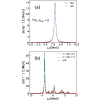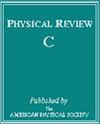Axially deformed relativistic quasiparticle random-phase approximation based on point-coupling interactions
IF 3.4
2区 物理与天体物理
Q1 Physics and Astronomy
引用次数: 0
Abstract
Collective nuclear excitations, like giant resonances, are sensitive to nuclear deformation, as evidenced by alterations in their excitation energies and transition strength distributions. A common theoretical framework to study these collective modes, the random-phase approximation (RPA), has to deal with large dimensions spanned by all possible particle-hole configurations satisfying certain symmetries. It is the aim of this work to establish a new theoretical framework to study the impact of deformation on spin-isospin excitations, that is able to provide fast and reliable solutions of the RPA equations. The nuclear ground state is determined with the axially deformed relativistic Hartree-Bogoliubov (RHB) model based on relativistic point-coupling energy density functionals (EDFs). To study the excitations in the charge-exchange channel, an axially deformed proton-neutron relativistic quasiparticle RPA (pnRQRPA) is developed in the linear response approach. After benchmarking the axially deformed pnRQRPA in the spherical limit, a study of spin-isospin excitations including Fermi, Gamow-Teller (GT), and spin-dipole (SD) is performed for selected -shell nuclei. For GT transitions, it is demonstrated that deformation leads to a considerable fragmentation of the strength function. A mechanism inducing the fragmentation is studied by decomposing the total strength to different projections of total angular momentum and constraining the nuclear shape to either spherical, prolate, or oblate. A similar fragmentation is also observed for SD transitions, although somewhat moderated by the complex structure of these transitions, while, as expected, the Fermi strength is almost shape independent. The axially deformed pnRQRPA introduced in this work open perspectives for the future studies of deformation effects on astrophysically relevant weak interaction processes, in particular beta decay and electron capture.

基于点耦合相互作用的轴向变形相对论准粒子随机相近似
集体核激发(如巨共振)对核变形很敏感,其激发能量和转变强度分布的变化就证明了这一点。研究这些集体模式的常用理论框架--随机相近似(RPA)--必须处理满足特定对称性的所有可能的粒子-空穴构型所跨越的大维度。这项工作的目的是建立一个新的理论框架,以研究形变对自旋-异空间激发的影响,该框架能够提供快速可靠的 RPA 方程解。核基态是通过基于相对论点耦合能量密度函数(EDFs)的轴向变形相对论哈特里-博戈利乌波夫(RHB)模型确定的。为了研究电荷交换通道中的激发,采用线性响应方法开发了轴向变形质子-中子相对论准粒子 RPA(pnRQRPA)。在对球面极限的轴向变形 pnRQRPA 进行基准测试后,对选定的 pf 壳核进行了自旋等离子激元研究,包括费米、伽莫-泰勒(GT)和自旋偶极子(SD)。对于 GT 转变,研究表明形变会导致强度函数发生相当程度的破碎。通过将总强度分解为总角动量 K 的不同投影,并将核形状限制为球形、长圆形或扁圆形,研究了诱导分裂的机制。在 SD 转变中也观察到了类似的碎裂现象,尽管这些转变的复杂结构在一定程度上缓和了碎裂现象,但正如预期的那样,费米强度几乎与形状无关。这项工作中引入的轴向变形 pnRQRPA 为今后研究变形对天体物理学相关弱相互作用过程(尤其是β衰变和电子俘获)的影响开辟了前景。
本文章由计算机程序翻译,如有差异,请以英文原文为准。
求助全文
约1分钟内获得全文
求助全文
来源期刊

Physical Review C
物理-物理:核物理
CiteScore
5.70
自引率
35.50%
发文量
0
审稿时长
1-2 weeks
期刊介绍:
Physical Review C (PRC) is a leading journal in theoretical and experimental nuclear physics, publishing more than two-thirds of the research literature in the field.
PRC covers experimental and theoretical results in all aspects of nuclear physics, including:
Nucleon-nucleon interaction, few-body systems
Nuclear structure
Nuclear reactions
Relativistic nuclear collisions
Hadronic physics and QCD
Electroweak interaction, symmetries
Nuclear astrophysics
 求助内容:
求助内容: 应助结果提醒方式:
应助结果提醒方式:


